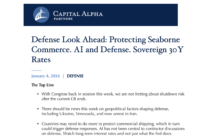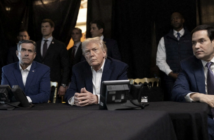Welcome to the CavasShips Podcast with Christopher P. Cavas and Chris Servello…a weekly podcast looking at naval and maritime events and issues of the day – in the US, across the seas and around the world. This week…We talk fleet size, force posture and budget priorities with long-time defense thinker and author Mackenzie Eaglen of American Enterprise Institute.
Please send us feedback by DM’ing @CavasShips or @CSSProvision or you can email chriscavas@gmail.com or cservello@defaeroreport.com.
This Week’s Naval Round Up:
As was widely reported, US forces struck late February 2 at Iranian-related targets in Syria and Iraq in retaliation for an unmanned aerial drone attack on January 28 that killed 3 US servicemembers and injured 34 more at a logistics base in Jordan near the Syrian border. As we record this there is no information that US Navy forces were involved in these latest strikes, but the White House said this was the first of several strikes expected to continue in coming days.
Meanwhile Houthi attacks on shipping continued in the Red Sea and Gulf of Aden, even as US and UK forces continued to selectively strike Houthi missiles, launch and control sites in Yemen. On January 26 a Houthi anti-ship missile hit the Marshall Islands-flagged oil tanker MARLIN LUANDA, who caught fire in the Gulf of Aden.
Destroyer USS CARNEY, French frigate ALSACE and the Indian destroyer VI-SAK-A-PAT-NAM VISAKHAPATNAM helped rescue the tanker’s crew and fight fires on the ship, and the fires were eventually extinguished on January 28. CARNEY, along with destroyer USS GRAVELY in the Red Sea, also shot down Houthi missiles and destroyed what US CENTCOM said were three Iranian UAVs during the week. And on February 1 a Houthi unmanned explosive boat was destroyed heading towards shipping in the Red Sea.
Deployed aircraft carriers CARL VINSON CVN70 and THEODORE ROOSEVELT CVN71 operated together in the Philippine Sea on January 31, joined by the Japanese helicopter carrier ISE for what was termed a “Multi-Large Deck Event.” CARL VINSON has been deployed only since October, while TR left San Diego in mid-January. It’s expected one of the strike groups could move on to the Mideast region and relieve the DWIGHT D EISENHOWER CVN69 in US Central Command.
British carrier HMS QUEEN ELIZABETH reportedly is ready to deploy from Portsmouth, England on February 4 to take part in NATO Exercise Steadfast Defender in the North Sea. British media in late January have been reporting that the UK Ministry of Defence has decided to send one of Britain’s two carriers to the MidEast but so far have declined to say which of the Royal Navy’s two carriers could go. HMS PRINCE OF WALES, the other carrier, also is at Portsmouth undergoing pierside maintenance.
And in new ship news, the amphibious dock transport ship RICHARD M McCOOL JR LPD29 completed builder’s sea trials at the end of January, HII’s Ingalls Shipbuilding announced February 1. The McCOOL is the second Flight I+ variant of the San Antonio LPD 17-class of ships. The ship is expected to be delivered to the US Navy later this year following successful acceptance trials. Three more Flight II LPDs are building at Ingalls, although further procurement has been suspended by the Pentagon pending further study.
And in old ship news, a ceremony was held February 2nd at Naval Sea Systems Command to mark the standup of the CVN Inactivation and Disposal Program Office, or PMS368. The office will oversee the disposal of nuclear-powered aircraft carriers beginning with ENTERPRISE CVN 65, now stored at Newport News, Virginia. Disposal of each of the nuclear carriers will be phenomenally expensive, estimated to be over a billion each.
Cavas Squawk:
This past week the White House’s tight lid on showing US Navy activities in the Mideast and eastern Mediterranean eased just a bit. Reporting teams from CBS News and ABC News, including CBS primary news anchor Norah O’Donnell, reported from on board several warships in the Med and Red Seas. It was a welcome respite from the limited – albeit continual — press releases and near-negligible imagery that has accompanied US Navy activities in the region since the Israel/Hamas war broke out in October.
As regular listeners to this podcast know, both of us believe that getting the word out via independent media to show what the US Navy does is a foundation to creating better awareness of the importance of what the sea services do. There is no better path to believing in something than seeing it in action. It’s why I lobbied the Navy – successfully, I might add – several years ago to allow media on board the carrier GERALD R FORD at sea, to see the world’s most expensive ship up close and get a better feel for why it took seemingly forever to finish it and what the real problems were. Up to that point no media had been allowed on board while the ship was at sea for its protracted series of trials, and the buzz around the ship and the Ford-class program was almost universally negative.
And somehow that changed. As more and more media were allowed to see the ship – and equally importantly, talk to its people – and report on it the public narrative gradually changed. To be sure, thousands of people were working very hard, mostly behind the scenes, to make that happen, but the word simply wasn’t getting out.
The ship’s shakedown deployment in the fall of 2022 allowed even more people to see and report on the ship, including international visits in Canada and to the United Kingdom. Then last May the FORD got underway for her maiden full deployment, on station in the Mediterranean as a display of American intentions in the European theater. Multiple media embarks reported enthusiastically on the ship, and by all accounts, the deployment – extended due to the Mideast war – was a great success. The ship, its crew and the entire program have moved on from the constant negative narrative that accompanied the program virtually from its inception. The Navy, its people and the industry that supports it made all that happen, but it needed to be reported on fairly and impartially.
The same thing applies to what the Navy and the US is doing now not just in the Mideast but also in the western Pacific and around the world. Media embarks – the working term for extended visits on board a Navy ship at sea – deserve to be supported by the Pentagon and the country’s top leadership. It’s nice that the doors opened a bit this week for the biggest media entities – network television – but much more can still be done. There are dozens if not hundreds of media requests for similar embarks – the Pentagon should act now to allow onboard more reporters – not just mainstream major media, but trade press and international media as well. If you want people to trust and appreciate you, you’re going to have to trust and appreciate what they can do for you.




